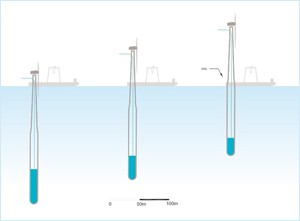Two researchers from the Universitat Politècnica de Catalunya’s (UPC) Department of Civil and Environmental Engineering have developed a new model for floating structures designed for offshore wind turbines anchored in deep, deep waters. Climent Molins’ and Alexis Campos’ prototype, WindCrete, is a cylindrical structure with a large float and ballast base that enables the platforms to be self-stabilizing.
 The researchers say the main innovation of this model compared to similar ones already on the market are seamless, monolithic structure and the use of concrete for its construction. This model uses concrete instead of steel, which is more expensive, and thus reduces costs by an estimated 60 percent, according to Molins and Campos. The researchers also say the concrete is more resistant in the marine environment, and as a result, the structure has fewer maintenance requirements and a lifespan of approximately 50 years. The structure is also absence of joints and this increases its durability against the effects of wind and sea avoids the damage that typically appears in transition areas.
The researchers say the main innovation of this model compared to similar ones already on the market are seamless, monolithic structure and the use of concrete for its construction. This model uses concrete instead of steel, which is more expensive, and thus reduces costs by an estimated 60 percent, according to Molins and Campos. The researchers also say the concrete is more resistant in the marine environment, and as a result, the structure has fewer maintenance requirements and a lifespan of approximately 50 years. The structure is also absence of joints and this increases its durability against the effects of wind and sea avoids the damage that typically appears in transition areas.
The researchers explain that the WindCrete includes a 5 MW wind turbine that can carry rotors of up to 15 MW with only an incremental cost. This new system reduces the cost of wind energy to 12 cents per kilowatt hour. According to Molins and Campos, this is half the price per kWh for this type of energy in the Canary Island, an area that will rely on offshore wind power.
The prototype was developed within the framework of the European project Alternative floating offshore substructure for offshore wind farms, which is carried out in the framework of KIC-InnoEnergy in collaboration with Stuttgart Wind Energy at the University of Stuttgart and Gas Natural Fenosa. A preliminary design was carried out to ensure technical and economic feasibility.

